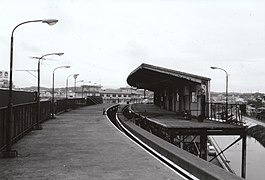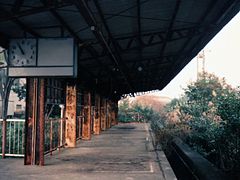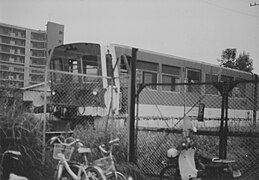Yokohama Dreamland Monorail
| Yokohama Dreamland Monorail | |||||||||||||||||||||||||
|---|---|---|---|---|---|---|---|---|---|---|---|---|---|---|---|---|---|---|---|---|---|---|---|---|---|
|
Former route along the Udagawa brook (2004)
| |||||||||||||||||||||||||
| Route length: | 5.3 km | ||||||||||||||||||||||||
| Power system : | 1500 V = | ||||||||||||||||||||||||
| Maximum slope : | 100 ‰ | ||||||||||||||||||||||||
| Top speed: | 60 km / h | ||||||||||||||||||||||||
| Society: | Dream transportation | ||||||||||||||||||||||||
| Route | |||||||||||||||||||||||||
|
|||||||||||||||||||||||||
The Yokohama Dreamland Monorail ( Japanese 横 浜 ド リ ー ム ラ ン ド モ ノ レ ー ル , Yokohama Dorīmurando Monorēru ) was a monorail on the Japanese island of Honshū . Located in the area of the city of Yokohama in Kanagawa Prefecture , it connected the Ōfuna train station with the Yokohama Dreamland amusement park . Due to serious construction defects, it was only in operation for a little over 16 months, from May 1966 to September 1967. In the 35 years that followed, there were unsuccessful attempts to put the line back into operation or to build a new one. Finally, it was shut down in 2002 and then canceled.
Track and vehicles
The starting point was the Ōfuna station , an important railway junction on the border between the cities of Yokohama and Kamakura ( ). The station of the monorail was there on the west side of the station. The completely elevated route with a total of 256 support pillars crossed the Kashio River and led northwest over slightly hilly terrain in the Harajuku district and across National Road 1 . For a short section it followed the Udagawa stream in a north-easterly direction, before turning again to the north-west and ending after 5.3 km in front of the entrance to the amusement park in the Dreamland station ( ). The 1500 V DC electrified line was single track, which is about to edge häfte in Kosuzume ( ) a turnout was.
![]()
![]()
![]()
The plant was one of only two saddle webs of the type Toshiba (the other inverted in Nara Dreamland ). Both trains used were composed of three cars, which were connected by bogies . A train could carry up to 198 people. At a maximum speed of 60 km / h and a maximum gradient of 100 per thousand, the journey time was eight minutes.
photos
history
The Yokohama Dreamland , one of the first modern amusement parks in the country, opened on August 1, 1964 , was very poor in terms of transport links. On weekends, for example, a bus on the completely congested streets to and from the nearest Ōfuna train station took up to an hour. Soon afterwards, the park operator Japan Dream Tourism decided to build a monorail and founded the subsidiary Dream Transport (Japanese ド リ ー ム 交通 , Dorīmu Kōtsū ) for this purpose . At that time, there was rapid population growth in the region, so the idea arose to open the railway to commuter traffic. For this reason, the Kosuzume siding was given a central platform. In addition, the line was later to be extended to Mutsuai Station or Chōgo Station (both on the Odakyū Enoshima Line ). The monorail was opened on May 2, 1966 and immediately proved to be a great success, despite the relatively high fare of 170 yen (value at that time corresponds to around 7 euros in 2020).
Frequent unusual incidents, such as blown tires or broken axles , resulted in an investigation by the Ministry of Transportation. She concluded that the chassis were too weak. Dream Transport then limited the maximum number of passengers to about half, reduced the maximum speed and stopped operating in strong winds. In April 1967 cracks began to be found in the supporting pillars. At the urging of the authorities, operations were initially temporarily suspended on September 21, 1967, and five days later for good. Before construction, Dream Transport was not able to acquire all the necessary land along the originally planned route and therefore had to change the route, which resulted in gradients of up to 100 per thousand. The cars had been adjusted accordingly, but the heavier traction motors increased their weight significantly. The construction company Mitsui Construction, on the other hand, had not been instructed to increase the load-bearing capacity of the concrete supporting pillars, which is why they gradually no longer withstand the load and began to burst.
Dream Transport sued the vehicle manufacturer Toshiba for damages in November 1967. The legal process dragged on and lasted more than 13 years. Finally, in January 1981, in a settlement proposed by the Tokyo District Court, Toshiba agreed to pay Japan Dream Tourism compensation of 2.6 billion yen. However, the no longer maintained wagons and systems had been left to decay, which is why it was no longer possible to resume operations with the money from the settlement. In 1987 the wagons were scrapped, in 1991 the transmission lines and signals were removed and in February 1992 the station at Ōfuna station was demolished.
In March 1982 Dream Transport transferred the operating and business license to the company Dream Development (Japanese ド リ ー ム 開 発 , Dorīmu Kaihatsu ), a subsidiary of the Daiei retail chain founded six months earlier . She strove to reopen the line in the long term, especially since the economic conditions seemed favorable. This was all the more true in 1988, during the bubble economy , when Daiei financed the Yokohama Dreamland (and took it over five years later). Serious planning began in 1995; It was planned to replace the technically outdated monorail with a magnetic levitation train of the type High Speed Surface Transport . Construction work should start in 1997 and last two years. Protests from residents concerned about the electromagnetic radiation , as well as the high costs associated with the new technology, caused this plan to fail in 2001. Instead, Daiei suggested a conventional monorail, but due to the severe Japanese economic crisis , the company did not have the necessary capital to build the railway. The Yokohama Dreamland closed on February 17, 2002, and on August 21 of the same year, Daiei announced that it would finally abandon the monorail. The demolition of the line, which was contractually agreed with the city of Yokohama, began in September 2003 and was completed a year and a half later.
Web links
- Archived Dream Development website (1999, Japanese)
Individual evidence
- ↑ ド リ ー ム ラ ン ド 跡 地 の 位置 図. (PDF, 350 kB) City of Yokohama, archived from the original on February 19, 2004 ; Retrieved April 27, 2020 (Japanese).
- ↑ a b c ド リ ー ム 交通 モ ノ レ ー ル 線 の 概要. In: Dreamland Monorail. f40.cc, accessed April 27, 2020 (Japanese).
- ↑ さ よ な ら YDL. Yokohama XY, February 17, 2020, accessed April 26, 2020 (Japanese).
- ^ Yomiuri Shinbun , Sept. 26, 1967 (morning edition).
- ↑ Nihon Keizai Shinbun , January 26, 1981 (evening edition).
- ↑ ド リ ー ム 交通 モ ノ レ ー ル 線 の 年表. In: Dreamland Monorail. f40.cc, accessed April 27, 2020 (Japanese).
- ↑ Railway Office of the Ministry of Transport (ed.): 平 成 九 年度 鉄 道 要 覧 . Denkisha kenkyūkai, Chiyoda 1997.
- ↑ Daiei unit gives up rights to Kanagawa monorail. The Japan Times , August 22, 2002, accessed April 27, 2020 .




